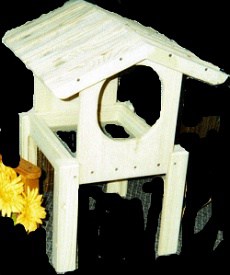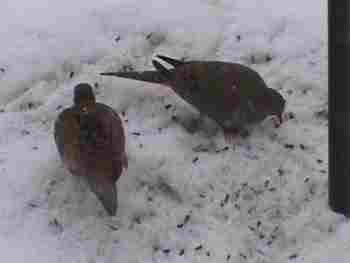1. General Ground Bird Feeder Review
- A ground bird feeder can be simply a patch of ground scattered with seed. The area should be open and visible to the birds, so they will be attracted to it.
- The ground itself will serve best for this purpose if it is a little sandy. The sandy soil will allow the rain water to drain away faster, which then lets the seed dry.
- It is a good idea to rotate the site on a regular basis using 3 or 4 different locations. To prevent seed build up and disease a daily raking of the area is recommended.
- The area chosen for a ground bird feeder should be five to six feet from a tree or bush. This is important for the birds so they have a refuge to flee to if a predator is spotted.
- Shelter from the wind is also very important. The seed will be blown away and scattered far and wide if there is no protection. The birds will also need some protection from the wind, especially during inclement weather.
- Pole mounted or hanging bird feeders inadvertently “supply” seed for ground feeding birds. This takes place during the usual feeding style of wild birds, by tossing out what they don’t like or by seed accidentally being pushed out.
Why Use a Homemade Ground Feeder?

Ground bird feeders can also be manufactured or homemade structures.
They have some distinct advantages to just tossing seed on the ground.
Although shelter from the wind and a refuge like a tree or bush, as mentioned above, are also very important factors for human made ground feeders.
Any raised flat surface, a foot off the ground is considered a ground feeder.
Some additional features though, will greatly enhance the enjoyment and use of this type of feeder.
If sprinkling seed on the ground for birds to eat, keep it raked & trash any seed beginning to mold or rot.
2. What are the Best Features of a Good Ground Bird Feeder?
- An edge about an inch above the flat feeding surface will help to keep the seed from blowing away.
- Leave the corners open on the edging to allow drainage and make cleaning easier when sweeping off the surface.
- You can also cut the legs shorter on one side to slope the surface for better drainage. Or…
- You can drill holes in the feeding surface for allowing water to drain. Or…
- Window screening can be used for the flat seed surface. The screen allows the seed to air dry quickly. Aluminum window screens won’t rust either.
- The bigger the table surface, the more birds that will be attracted, especially the sociable ones like Finches.
- A roof that overhangs the seed table surface, will protect the seed from the elements and the wild birds from overhead predators.
-
- Evergreens make excellent wind barriers and shelters. If natural shelter is not close by then a barrier can be erected.
To make a wind barrier erect wire fencing on the windward side of the location where you choose for your ground feeder. Cedar boughs can then be woven through the wires or attached to the fencing.
You can also build a brush pile close to the ground feeder as a weather barrier and for a place the wild birds can flee to in case of a predator.
- A shelter can be erected with cedar boughs to cover the ground bird feeder area. Build a tripod or a “four pod” with sturdy branches, 3 to 4 inches wide, and lash them together at the top. In the case of a four pod drape the top half of the structure with fencing. Then attach cedar boughs on top of the fencing
to form a roof. The seed can be scattered on the ground underneath.
Find a good selection of ground bird feeders here.
3. List of Styles
- The ground itself can simply be used as a “ground” feeder.
- Any raised flat surface, a raised off the ground, can be used as a ground bird feeder.
- A roof will help protect the seed from rain, snow and ice.
- The seed surface can be made of wood, metal, perforated metal or screen. Drainage is important to allow the rain water to drain away preventing the seed from rotting.
4. What is the Best Seed Choice for This Feeder?
Sprinkle a mixture of whole corn kernels, cracked corn, black oil sunflower seed, striped sunflower seed, white millet, buckwheat, sorghum or a type of sorghum, called milo on the feeding surface of your feeder.
This mixture will be well received by Mourning Doves, some types of Sparrows, Juncos, Pigeons and a variety of your usual backyard feeder birds.
If you are close to open country or forest your ground bird feeder may also attract gallinaceous birds.

These birds nest on the ground and fly short distances, such as domestic fowls, pheasants, grouse, quails and wild turkeys.
Of course Mourning Doves will try to own your ground feeder. ?
Discover Different Types of Bird Feeders
- Bluebird Feeder – The wriggly morsels that are placed in Bluebird feeders do have charming ways, not only for Bluebirds but many other species too.
- Tube Feeders – This type of feeder can be used to attract smaller specific types of birds. They also serve as a deterrent for birds which are considered pests
- Thistle Feeders and thistle seed are just what the “bird” doctor ordered if you want to attract Goldfinches to your yard.
